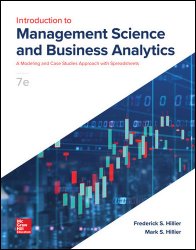Introduction to Management Science and Business Analytics: A Modeling & Case Studies Approach with Spreadsheets, 7th Edition
- Добавил: literator
- Дата: 20-06-2024, 14:10
- Комментариев: 0
 Название: Introduction to Management Science and Business Analytics: A Modeling & Case Studies Approach with Spreadsheets, 7th Edition
Название: Introduction to Management Science and Business Analytics: A Modeling & Case Studies Approach with Spreadsheets, 7th EditionАвтор: Frederick Hillier, Mark Hillier
Издательство: McGraw Hill
Год: 2023
Страниц: 769
Язык: английский
Формат: pdf (true)
Размер: 26.2 MB
For well over a decade now, we have seen a growing analytics revolution. As we have entered the era of Big Data, analytics (including Data Science) now plays a key role in dealing with numerous managerial concerns. Business analysts who analyze these problems no longer can depend primarily on using the techniques of management science. The discipline of business analytics now needs to be used as well. To meet this need, business schools now have substan- tially increased their coverage of business analytics. In fact, many business schools now offer a master’s program in business analytics. Therefore, without reducing the coverage of management science, we now are providing an introduction to business analytics as well to clarify the close relationship between these two disciplines.
This is done mainly in the first three chapters (plus Chapter 4, which was Chapter 10 in the sixth edition). Chapter 1 is partially new in describing business analytics and its relationship to management science. Chapter 2 is completely new in providing an overview of a major study that draws on the techniques of business analytics and management science working together. Chapter 3 is completely new in presenting some basic kinds of models for performing predictive analytics. Just as in the sixth edition, Chapter 4 (formerly Chapter 10) presents another type of predictive analytics, namely, using historical data to make a forecast of what the value of some future quantity will turn out to be. Therefore, students now can gain a much better understanding of how business analytics and management science complement each other.
However, Chapters 5–15 (plus the Web chapters) present essentially all of the management science material that was in the sixth edition. Therefore, this gives management science instructors considerable flexibility in how to use this book. If they don’t have the space or inclination to provide a significant coverage of business analytics, they can go directly from Chapter 1 to Chapters 5–15. If they want to include an overview of how business analytics and management science can work together, Chapter 2 can be included as well. If they want a fuller introduction to business analytics while still providing a more thorough introduction to management science, Chapter 3 and perhaps Chapter 4 can be included as well.
Master’s programs in business analytics typically include a course that is devoted mainly to presenting the techniques of management science and operations research. This textbook should be well suited for such a course.
As discussed in the following three subsections, we continue to believe that a modern introductory management science textbook should have three key elements. As summarized in the subtitle of this book, these elements are a modeling and case studies approach with spreadsheets.
The modern approach to the teaching of management science clearly is to use spreadsheets as a primary medium of instruction. Both business students and managers now live with spreadsheets, so they provide a comfortable and enjoyable learning environment. Modern spreadsheet software, including Microsoft Excel used in this book, now can be used to do real management science. For student-scale models (which include many practical real-world models), spreadsheets are a much better way of implementing these models than traditional algebraic solvers. This means that the algebraic curtain that used to be prevalent in traditional management science courses and textbooks now can be lifted.
However, with the current enthusiasm for spreadsheets, there is a danger of going overboard. Spreadsheets are not the only useful tool for performing management science analyses. Occasional modest use of algebraic and graphical analyses still have their place and we would be doing a disservice to the students by not developing their skills in these areas when appropriate. Furthermore, the book should not be mainly a spreadsheet cookbook that focuses largely on spreadsheet mechanics. Spreadsheets are a means to an end, not an end in themselves.
Contents:
Скачать Introduction to Management Science and Business Analytics: A Modeling & Case Studies Approach with Spreadsheets, 7th Edition
Внимание
Уважаемый посетитель, Вы зашли на сайт как незарегистрированный пользователь.
Мы рекомендуем Вам зарегистрироваться либо войти на сайт под своим именем.
Уважаемый посетитель, Вы зашли на сайт как незарегистрированный пользователь.
Мы рекомендуем Вам зарегистрироваться либо войти на сайт под своим именем.
Информация
Посетители, находящиеся в группе Гости, не могут оставлять комментарии к данной публикации.
Посетители, находящиеся в группе Гости, не могут оставлять комментарии к данной публикации.

